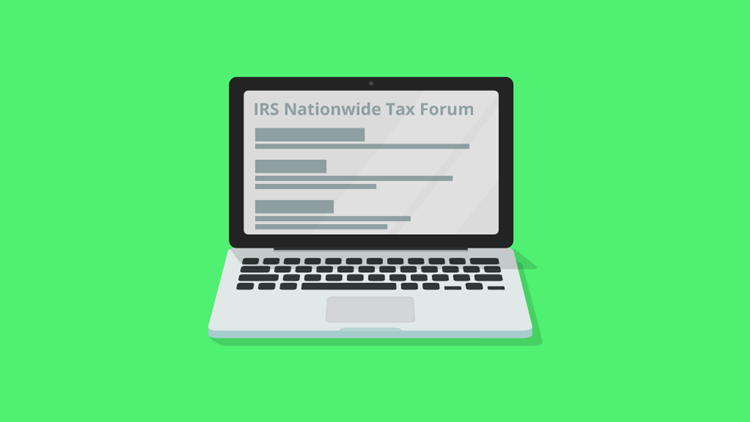by | Mar 12, 2022 | Tax Tips and News
The Internal Revenue Service is relying on technology to help it keep up with its growing need for taxpayer support. The agency has begun using voice and chat bots on a pair of specialized telephone assistance lines and on its website.
These new features are expected to help taxpayers get answers to simple payment or collection notice questions quickly, while avoiding wait times for a human representative.
Taxpayers can, of course, still remain on the line for an IRS telephone representative if they really need one.

“Our phone lines continue to see unprecedented demand, and the IRS continues to look for ways to help people and avoid long wait times,” said IRS Commissioner Chuck Rettig. “Our telephone representatives remain an important part of the service we provide, but these bots can help some people avoid lengthy phone delays for something that could be resolved on the spot. This is part of a larger effort to help people get the assistance they need this tax season.”
The voice and chat bots have been deployed in English- and Spanish-speaking versions, giving taxpayers help with tax payment issues, or with an IRS notice they have received. Taxpayers with more general tax season questions probably won’t encounter one of these bots at this time, the IRS says.
The bots are helping taxpayers with issues such as how to make one-time payments, answers to frequently asked questions, or clarification of collection notices.
So, what is a ‘bot,’ anyway?
Bots are basically software; in this case, software powered by artificial intelligence (AI). Voice bots allow the caller to navigate through the system of menus – called the interactive voice response system or IVR – using their voice and their natural language.
Chat bots can simulate human conversation, interacting through text. Like the voice bot, chat bots use AI to respond to natural language in a normal way.
Some taxpayers, of course, may need to speak to a human customer service representative. Those callers who do need human assistance will be placed on hold for either English or Spanish telephone assistance.
The voice and chat bots deployed by the IRS provide unauthenticated services, which means they are not able to help with issues that involve a taxpayer’s protected account information.
But for many taxpayers, the bots can be a welcome shortcut to easy answers.
“Voice and chat bots interact with taxpayers in easy-to-follow ways, which means taxpayers don’t have to wait on hold to handle simple tasks,” said Darren Guillot, Commissioner of Small Business/Self Employed Collection at the IRS.
This new IRS deployment builds on previous AI experience. The IRS used voice bots to help callers to its Economic Impact Payment (EIP) toll-free line, where they gave general answers to frequently asked questions. In February, voice bots were used on the Advance Child Credit toll-free line, giving similar help to taxpayers reconciling the credits on their 2021 tax return.
The IRS plans to add more bots in the future
Look for more bots within the IRS experience later this year. The IRS expects to have voice bots help taxpayers authenticate their identity so they can establish payment plans, request transcripts and to get information such as payoff amounts from their accounts.
And the IRS expects to have more voice and chat bots on the job later in 2022 helping taxpayers with even more complex issues.
The IRS bot rollout carries the promise of big dividends for the agency’s customer service departments. The IRS toll-free telephone lines get millions of calls every year. The average customer service representative spends some 20 minutes with every taxpayer they help with a collection issue.
If the bots can field the simple questions, that frees customer service representatives to deal with the more complex issues while cutting wait times for callers.
For more information, see the other self-service options available on the IRS website.
Source: IR-2022-56
– Story provided by TaxingSubjects.com
by | Mar 11, 2022 | Tax Tips and News
With tax season in full swing, the Internal Revenue Service wants taxpayers to be sure they’re not overlooking ways they could lessen their tax liabilities. To take advantage of one method, though, taxpayers have to be fairly quick, because there’s a deadline to meet.
The road to deductions in this case is through contributions to an Individual Retirement Arrangement (IRA) made through April 18.

How do taxpayers qualify for IRA deductions?
By definition, an IRA is a personal savings plan, letting employees and the self-employed save for retirement and enjoy some tax advantages. Contributions can be made for 2021 to a traditional IRA or to a Roth IRA until the filing deadline of April 18, but the contributions have to be designated for 2021 to the financial institution.
Eligible taxpayers can contribute as much as $6,000 to an IRA for the 2021 tax year in most cases. If the taxpayer is age 50 or older, the limit goes up to $7,000.
Qualified contributions to traditional IRAs can be deductible right up to the contribution limit, or 100% of the taxpayer’s compensation, whichever is less.
While there used to be an age limit for making a contribution to one’s IRA, that’s no longer the case.
Taxpayers may be able to claim the Saver’s Credit, if they make qualified contributions to one of a specific group of retirement plans; this includes a 401k, 403(b), an IRA, or an Achieving a Better Life Experience (ABLE) account.
The amount of the credit—also known as the Retirement Savings Contributions Credit—is usually based on how much money the taxpayer contributes, their adjusted gross income and filing status.
The lower the income, the higher the amount of the tax credit. While taxpayers are eligible for the credit, dependents and full-time students aren’t.
Read Publication 907, Tax Highlights for Persons with Disabilities, for more information on annual contributions to an ABLE account.
There are different rules for Roth
Contributions to a Roth IRA aren’t deductible, but this type of IRA carries a different kind of benefit, allowing qualified distributions that are tax-free.
Taxpayers can make contributions to their own traditional IRA and/or Roth IRA, even if they already participate in a retirement plan sponsored by their employer. This includes SEP or SIMPLE IRA-based plans.
The IRS website has more information on contributions to retirement plans and possible deductions, including:
Source: IR-2022-52
– Story provided by TaxingSubjects.com
by | Mar 9, 2022 | Tax Tips and News
The Internal Revenue Service has inaugurated its new Taxpayer Experience Office and plans are already in the works to expand this new long-term effort to improve service to America’s taxpayers.
IRS Commissioner Chuck Retting sees the startup of the Taxpayer Experience Office as vital for the future of his agency.
“As the IRS continues taking immediate steps this filing season including adding more employees to address the significant challenges facing a resource-constrained IRS, it’s critical that we work going forward to equip the IRS to be a 21st century resource for Americans,” Commissioner Rettig said. “The formal establishment of this office will help unify and expand efforts across the IRS to improve service to taxpayers.”
The new office will shine a spotlight on all the says taxpayers interact with the IRS, with special attention into the service, compliance and other program areas. All the various IRS business units will also be fully involved, working closely with the Taxpayer Advocate Service.
Origins of the Taxpayer Experience Office
The new office has its roots in the Taxpayer First Act and its report to Congress, made last year. This report featured input and feedback from a number of taxpayers, tax pros and the tax community at large that helped in turn to develop the Taxpayer Experience Strategy.
The Report to Congress generated a list of over a hundred different programs and tools that could help taxpayers. The list included a “360-degree view” of taxpayer accounts, expanded e-file and payment options, digital signatures, secure two-way messaging and online accounts for businesses and tax professionals.
The Taxpayer Experience Office will drive the agency’s direction into the future, by identifying the key areas the IRS will focus on over the next five years. Commitments in the President’s Executive Order on Transforming Federal Customer Experience and Service Delivery to Rebuild Trust in Government are included in these key areas.
“The IRS is committed to customer experiences that meet taxpayers where they are, in the moments that matter most in people’s lives and in a way that delivers the service that the public expects and deserves,” said Chief Taxpayer Experience Officer Ken Corbin.
Corbin also serves as the commissioner of the Wage and Investment division, which oversees the current filing season and other activities.
Navigating the tax-paying experience
The new Taxpayer Experience Office has been tasked with charting the IRS’ way forward by identifying just what taxpayers expect from the agency and the trends within the tax industry. In addition, the new office will determine the best practices for good customer service, develop guidelines on the customer experience the IRS should provide and what taxpayers should reasonably expect from the IRS.
In support of all these projects, the IRS expects to add staff to the Taxpayer Experience Office in coming months.
“Whether checking the status of a tax return, meeting with a revenue agent for an audit, or receiving a tax credit to their bank account, improving service delivery and customer experience are fundamental priorities for us,” Corbin said. “We’re committed to designing and delivering services that better connect with our diverse taxpayer base.”
Detractors and advocates alike would agree there’s plenty of room for improvement for the IRS. The agency’s game plan calls for improvement in customer callbacks, expanding the IRS’s payment options, developing a secure two-way messaging system and providing more services for multilingual taxpayers.
Source: IR-2022-50
– Story provided by TaxingSubjects.com
by | Mar 5, 2022 | Tax Tips and News
Tax season may be far from over in 2022, but it’s not too early to make plans to attend this year’s IRS Nationwide Tax Forums, starting in July.
The event is seen throughout the income tax industry as the marquee outreach event for tax professionals, state and federal tax agencies and tax industry leaders. Historically, the forums have taken place in a number of cities around the country each summer, although the traveling venue format was interrupted by the COVID pandemic.

This year’s format follows a similar arrangement from 2020 and 2021, using a virtual environment and lived-streamed webinars. The Nationwide Tax Forum opens July 19 and continues through August 18. Live streamed webinars are available on Tuesdays, Wednesdays and Thursdays.
This year’s virtual event includes:
- A keynote address from Commissioner Charles Rettig;
- A plenary session with tax law and publications updates, and
- Multiple sessions on high-interest topics for the tax professional, with presentations by both IRS experts and partner associations.
Course details will be announced soon, along with webinar titles, descriptions and schedules.
Registration for the IRS Nationwide Tax Forums
Registration is now open for the 2022 IRS Nationwide Tax Forums. Tax pros are advised to register early for the best experience. Fully registered attendees get to take part in all the live webinars, visit the vendors in the Virtual Expo, and share their experiences in choice focus groups.
Attendance at the 2022 event also qualifies a tax professional for continuing education (CE) credits. This includes enrolled agents, certified public accountants, Annual Filing Season Program participants, California Tax Education Council (CTEC) participants and Certified Financial Planners (CFP).
Participants will have to abide by their respective licensing agency’s CE requirements.
For those who can’t attend this 2022 virtual main event, the IRS Nationwide Tax Forums Online (NTFO) has courses based on taped seminars from previous Tax Forums. The NTFO courses can be taken for CPE credit or for audit purposes.
It should be noted, however, that registration for NTFO is separate from registration for the IRS Nationwide Tax Forum.
Have questions about the 2022 IRS Nationwide Tax Forums? Email taxforums@irs.gov.
Come see us at the Tax Forums!
Be sure to visit the Drake Software virtual booth if you attend this year. We look forward to interacting with you!
Source: “IRS Nationwide Tax Forums Information“
– Story provided by TaxingSubjects.com
by | Mar 5, 2022 | Tax Tips and News
IRS Highlights Gig Economy, Virtual Currency, and Foreign Source Income
Some new sources of income sometimes go where tax law hasn’t gone before. This leads to income slipping through the cracks for a while until the law catches up.
The IRS wants taxpayers to know that in the areas of gig economy income, virtual currency and income from foreign sources, the cracks are disappearing.
That said, the Internal Revenue Service is also posting reminders and tools on its website that can help taxpayers stay abreast of their reporting responsibilities.

Reminder 1: Gig Economy Income is Taxable
As a rule of thumb, income generated in the gig economy—whether a full-time job or just a side hustle—is taxable and needs to be reported. Just because the work comes to the taxpayer through digital means such as an app, doesn’t mean it’s not income. Such income must be reported, even if it is:
- From part-time, temporary or side work,
- Not reported on an information return form – like a Form 1099-K, 1099-MISC, W-2 or other income statement or
- Paid in any form, including cash, property, goods or virtual currency.
The IRS’ gig economy tax center on its website has more good information on the gig economy.
Reminder 2: Virtual Currency Gains are Very Real Income
Virtual currency is now front-and-center in the IRS sights. At the top of the Form 1040 and the Form 1040-SR asks if the taxpayer has any virtual currency transactions. The answer is either a “yes” or a “no,’ so the answer should be carefully considered.
A reportable transaction with virtual currency includes the following types, but isn’t limited just to these examples:
- The receipt of virtual currency as payment for goods or services provided;
- The receipt or transfer of virtual currency for free (without providing any consideration) that does not qualify as a bona fide gift;
- The receipt of new virtual currency as a result of mining and staking activities;
- The receipt of virtual currency as a result of a hard fork;
- An exchange of virtual currency for property, goods or services;
- An exchange/trade of virtual currency for another virtual currency;
- A sale of virtual currency; and
- Any other disposition of a financial interest in virtual currency.
The IRS has a couple more heads-up hints that can help those taxpayers with virtual currency to report.
If any virtual currency held as a capital asset was disposed through a sale, exchange or transfer, the taxpayer should answer the question with a “yes” and figure a capital gain or loss on Form 8949 and report it on Schedule D (Form 1040).
Taxpayers who receive virtual currency as pay for services rendered – or who disposed of virtual currency they had for sale as part of a trade or business – also have to report the income just as they would if the crypto were conventional currency.
This means reporting W-2 wages, for example, on Form 1040 or Form 1040-SR, or reporting inventory or services on Schedule 1.
The instructions for Form 1040 have more on virtual currency, as does the virtual currencies webpage on IRS.gov.
Reminder 3: Report Income from Foreign Sources
Another rule of thumb, this time for U.S. citizens and resident aliens alike: Generally, worldwide income earned by these two groups of taxpayers is subject to U.S. income tax, no matter where they live. They also have the same income tax filing requirements as someone living within the U.S.
What’s on the table for those taxpayers living abroad?
Unearned income: any interest, dividends or pensions from sources other than the U.S. The only exception is if unearned income is from a country specifically exempted from such tax by law or tax treaty.
Earned income: this includes wages and tips received from foreign sources.
The IRS reminds that even if the taxpayer qualifies for tax benefit such as the Foreign Earned Income Exclusion or the Foreign Tax Credit, which can reduce or even eliminate the taxpayer’s tax liability, they still have requirement to file.
Taxpayers who have both their tax home and their residence outside of the U.S. and Puerto Rico get an automatic 2-month extension of time to file. However, even with this extension, those taxpayers living abroad will have to pay their tax due by April 18 or face interest charges.
Special rules apply to members of the U.S. military serving abroad. See Instructions for Form 1040 and 1040-SR, Publication 54, Tax Guide for U.S. Citizens and Resident Aliens Abroad, and Publication 519, U.S. Tax Guide for Aliens.
Reporting Foreign Accounts
American citizens and resident aliens also have a requirement to report their income from foreign sources such as trusts, bank accounts or other foreign accounts – even if the taxpayer lives in the U.S. Schedule B is used to report the existence of foreign accounts and usually requires disclosure of the country where the account is held.
Some taxpayers may have to attach Form 8938, Statement of Foreign Financial Assets to their tax return along with the Schedule B. This form is used by citizens, resident aliens and some nonresident aliens when the total value of their foreign financial assets are above certain limits.
When taxpayers have an interest in foreign financial accounts – or other authority over them – and the accounts had a total value more than $10,000 at any time during 2020, they have to file a form with the Treasury Department. The Financial Crimes Enforcement Network (FinCEN) Form 114, Report of Foreign Bank and Financial Accounts (FBAR) has to be filed electronically.
More information on all these foreign income filing requirements can be found in the Tax Time Guide series and Publication 17, Your Federal Income Tax.
Source: Tax Time Guide: IRS reminds taxpayers to report gig economy income, virtual currency transactions, foreign source income and assets
– Story provided by TaxingSubjects.com
by | Mar 2, 2022 | Tax Tips and News
“Just when I thought I was out, they pull me back in.”
– Michael Corleone, The Godfather: Part III
It turns out the Internal Revenue Service isn’t entirely done with facial recognition software after all. While the agency once again confirmed they will not require biometric data for IRS Online Account registration, it would remain an option for taxpayers who prefer that verification method—with additional security measures in place to protect taxpayers’ privacy.

On February 7, the IRS announced that it would “transition away from using a third-party service for facial recognition to help authenticate people creating new online accounts.” At the time, the agency noted that this transition would involve finding a new default security process that does not raise the same privacy concerns as requiring taxpayers to submit a selfie. Last week, the agency announced a “short-term solution.”
“Taxpayers will have the option of verifying their identity during a live, virtual interview with agents; no biometric data—including facial recognition—will be required if taxpayers choose to authenticate their identity through a virtual interview,” the IRS confirmed. These interviews will be the default authentication method for the tax-year 2022 filing season, but “the IRS will work closely with partners across government to roll out Login.Gov as an authentication tool … with the goal of introducing this option after the 2022 filing deadline.”
However, critics of third-party facial recognition software may not be satisfied that this method is still available, even if it’s purely optional. To address those concerns, the IRS noted that the service provider would be required to delete all images that are used for verification after the account has been created. Further, images that were received before the agency stopped requiring facial recognition “will also be permanently deleted over the course of the next few weeks.”
Source: “IRS Statement — New features put in place for IRS Online Account registration; process strengthened to ensure privacy and security,” IRS.gov
– Story provided by TaxingSubjects.com











